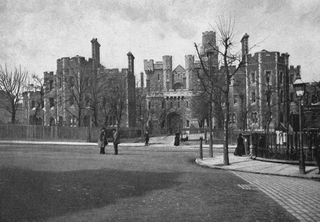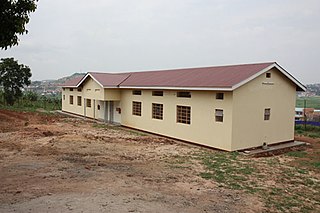
Elizabeth Fry, sometimes referred to as Betsy Fry, was an English prison reformer, social reformer, philanthropist and Quaker. Fry was a major driving force behind new legislation to improve the treatment of prisoners, especially female inmates, and as such has been called the "Angel of Prisons". She was instrumental in the 1823 Gaols Act which mandated sex-segregation of prisons and female warders for female inmates to protect them from sexual exploitation. Fry kept extensive diaries, in which she wrote explicitly of the need to protect female prisoners from rape and sexual exploitation.

HM Prison Pentonville is an English Category B men's prison, operated by His Majesty's Prison Service. Pentonville Prison is not in Pentonville, but is located further north, on the Caledonian Road in the Barnsbury area of the London Borough of Islington, north London. In 2015 the justice secretary, Michael Gove, described Pentonville as "the most dramatic example of failure" within the prisons estate.

HM Prison Holloway was a closed category prison for adult women and young offenders in Holloway, London, England, operated by His Majesty's Prison Service. It was the largest women's prison in western Europe, until its closure in 2016.

The Ohio Department of Rehabilitation and Correction is the administrative department of the Ohio state government responsible for oversight of Ohio State Correctional Facilities, along with its Incarcerated Individuals. Ohio's prison system is the sixth-largest in America, with 27 state prisons and three facilities for juveniles. In December 2018, the number of inmates in Ohio totaled 49,255, with the prison system spending nearly $1.8 billion that year. ODRC headquarters are located in Columbus.

The Federal Prison Camp, Alderson is a minimum-security United States federal prison for female inmates in West Virginia. It is operated by the Federal Bureau of Prisons, a division of the United States Department of Justice.
A reformatory or reformatory school is a youth detention center or an adult correctional facility popular during the late 19th and early 20th centuries in Western countries. In the United Kingdom and United States, they came out of social concerns about cities, poverty, immigration, and gender following industrialization, as well as from a shift in penology to reforming instead of punishing the criminal. They were traditionally single-sex institutions that relied on education, vocational training, and removal from the city. Although their use declined throughout the 20th century, their impact can be seen in practices like the United States' continued implementation of parole and the indeterminate sentence.
Elmira Correctional Facility, also known as "The Hill", is a maximum security state prison located in Chemung County, in the City of Elmira in the US state of New York. It is operated by the New York State Department of Corrections and Community Supervision. A supermax prison, Southport Correctional Facility, is located 2 miles (3.2 km) away from Elmira.
HM Prison Downview is a women's closed category prison. Downview is located on the outskirts of Banstead in Surrey, England, and is immediately adjacent to the southern boundary of Belmont in Greater London. The prison is operated by His Majesty's Prison Service, and is situated in proximity to High Down Prison for men.
Massachusetts Correctional Institution – Framingham (MCI-Framingham) is the Massachusetts Department of Correction's institution for female offenders. It is located in Framingham, Massachusetts, a city located midway between Worcester and Boston. The prison was once known as "Framingham State Prison". However, MCI-Framingham is its official name and is favored. As of May 2022 there are approximately 190 inmates in general population beds.
The Oklahoma State Reformatory is a medium-security facility with some maximum and minimum-security housing for adult male inmates. Located off of State Highway 9 in Granite, Oklahoma, the 10-acre (4.0 ha) facility has a maximum capacity of 1042 inmates. The medium-security area accommodates 799 prisoners, minimum-security area houses roughly 200, and the maximum-security area with about 43 inmates. The prison currently houses approximately 975 prisoners. The prison was established by an act of the legislature in 1909 and constructed through prison labor, housing its first inmate in 1910. The facility is well known for the significant roles women played in its foundation and governance, most notably having the first female warden administer an all-male prison in the nation.

The Ohio Reformatory for Women (ORW) is a state prison for women owned and operated by the Ohio Department of Rehabilitation and Correction in Marysville, Ohio. It opened in September 1916, when 34 female inmates were transferred from the Ohio Penitentiary in Columbus. ORW is a multi-security, state facility. As of July 2019, 2,394 female inmates were living at the prison ranging from minimum-security inmates all the way up to one inmate on death row. It was the fifth prison in the United States, in modern times, to open a nursery for imprisoned mothers and their babies located within the institution. The Achieving Baby Care Success (ABC) program was the first in the state to keep infants with their mothers.
HMP Peterhead was a prison in Peterhead in Aberdeenshire, Scotland, operating from 1888 to 2013. Since June 2016, the former grounds operate as the Peterhead Prison Museum.

The Andrew Mercer Reformatory for Women was a women's prison in Toronto, Ontario, Canada. At various times, the facility was also known as the Mercer Complex, Andrew Mercer Reformatory for Females, and Andrew Mercer Ontario Reformatory for Females.
Dwight Correctional Center (DCC), also known as Oakdale Reformatory for Women, and Illinois Penitentiary for Women at Dwight, was a women's prison in Livingston County, Illinois, United States, outside the village of Dwight, Illinois. It operated from 1930 to 2013.

A prison, also known as a jail, gaol, penitentiary, detention center, correction center, correctional facility, remand center, hoosegow, or slammer is a facility where people are imprisoned against their will and denied their liberty under the authority of the state, generally as punishment for various crimes. Authorities most commonly use prisons within a criminal-justice system: people charged with crimes may be imprisoned until their trial; those who have pled or been found guilty of crimes at trial may be sentenced to a specified period of imprisonment.

Luzira Maximum Security Prison is a maximum security prison for both men and women in Uganda. Until Kitalya Maximum Security Prison opened in 2020, Luzira was the only maximum security prison in the country and housed Uganda's death-row inmates.
Louisiana Correctional Institute for Women (LCIW) is a prison for women with its permanent pre-2016 facility located in St. Gabriel, Louisiana, United States. It is the only female correctional facility of the Louisiana Department of Public Safety and Corrections. Elayn Hunt Correctional Center is immediately west of LCIW. LCIW includes the state's female death row. As of 2017 the prison has temporarily moved due to flooding that occurred in August 2016, and its prisoners are housed in other prisons. The administration is temporarily located in the former Jetson Youth Center near Baker. By 2021 the Baker area address was given for the prison on the LCIW website.

The New York House of Refuge was the first juvenile reformatory established in the United States. It opened in 1824 on the Bowery in Manhattan, New York City and was destroyed by a fire in 1839, before being relocated first to Twenty-Third Street and then, in 1854, to Randalls Island.
Woking Convict Invalid Prison was constructed in mid-19th-century England, primarily to hold male invalid convicts who previously had been billeted on hulks and had been moved to the temporary invalid prison at Lewes. The concept of a prison specifically for invalids was seen as progressive at the time.

The Kentucky State Penitentiary in Frankfort was an American prison. It was the first prison built west of the Allegheny Mountains and completed on June 22, 1800 when Kentucky was still virtually a wilderness. The Kentucky Legislature of 1798 had appointed Harry Innes, Alexander S. Bullitt, Caleb Wallace, Isaac Shelby and John Coburn as commissioners to choose a location for a “penitentiary house.” The house was described "to be built of brick, or stone, containing cells, workshops, with an outside wall high enough and strong enough to keep the prisoners from getting away." The site chosen was Frankfort, Kentucky. Henry Innis, one of the commission, gave one acre of land and the legislature appropriated $500 towards its building with more funds to be allocated later.











